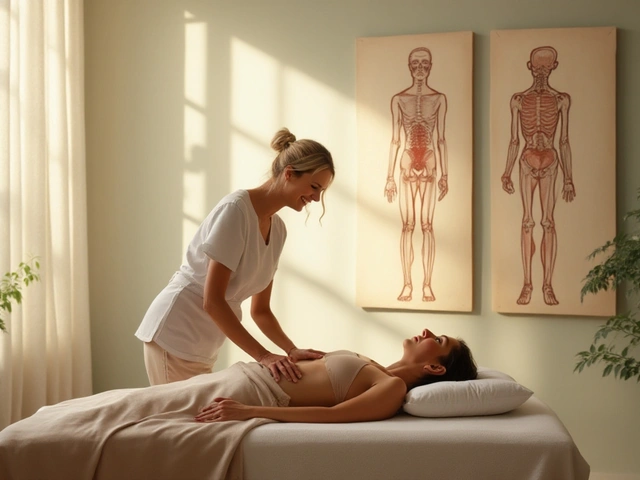Depression management
Feeling low often comes with tight muscles, foggy thinking, and crappy sleep. Some forms of hands-on care can help lift mood, ease tension, and make daily life feel less heavy. This page lists practical, evidence-backed ways massage and bodywork can support depression management and tells you what works, what to avoid, and how to fit it into real life.
Why touch helps: Physical touch lowers cortisol, boosts oxytocin and serotonin, and calms the nervous system. That’s not woo—research shows regular massage can reduce symptoms of anxiety and mild-to-moderate depression. Even short sessions that focus on calming techniques often help people sleep better and think clearer for days.
Which therapies tend to work best? Look for gentle, calming approaches: Swedish, Amma, warm stone, Lomi Lomi, and palliative massage focus on relaxation and comfort rather than deep pressure. Somatic methods like Feldenkrais, Hellerwork, and Ortho-Bionomy help you reconnect with your body and release chronic tension that feeds low mood. Energy-based options—acupressure, polarity therapy, or gentle reflex work—can be useful if you like a blended approach. Trigger point and deep tissue can help if muscle pain worsens mood, but only with consent and good aftercare.
Practical tips for choosing and using sessions
Pick a therapist who listens and makes you feel safe. Tell them you’re managing depression so they can use lighter pressure and include breath work or slow movement. Start with weekly or biweekly 30–60 minute sessions, then shift to monthly maintenance once you notice improvement. Try different styles for a few visits to see what resonates—some people respond to warm stone comfort, others to structural work or guided movement.
Short home practices matter. Try this simple acupressure routine: press the space between thumb and index finger (LI4) for one minute, then press two fingers above the inner wrist on the palm side (PC6) for one minute each side. Finish with three slow belly breaths. A warm shower before bed or a five-minute Feldenkrais-style gentle roll can extend session benefits.
Ask a few quick questions when booking: are you trained in mental health sensitive massage? Do you have experience with clients who are depressed? What techniques will you use? Also check policies on silence or talk during the session—some people want quiet, others need to chat.
Safety and when to get more help
Massage helps many but it’s not a replacement for therapy or meds. If you have thoughts of self-harm, severe sleep loss, or major life changes, reach out to a mental health pro immediately. Tell your therapist about medications, surgeries, pregnancy, or blood thinners—some techniques or heat won’t be safe. If touch feels overwhelming, ask for guided breath work, movement, or a no‑touch session.
Used with talk therapy, sleep work, gentle movement, and social support, massage and bodywork can make daily life easier. Try one small step this week—book a gentle session, practice the acupressure routine, or call a counselor for a combined plan—and notice if your sleep or mood nudges in a better direction.
If cost is an issue, ask about sliding scales, community clinics, or student clinics for affordable options.

The Role of Shiatsu in Managing Anxiety and Depression
Hi there! I just posted a new blog about the fascinating role of Shiatsu in managing both anxiety and depression. As a holistic healing technique, Shiatsu has much to offer if you're fighting these mental health challenges. By applying pressure to various points on the body, it may aid in balancing your internal energy to restore emotional harmony. Do pay a visit if you’d like to learn more and explore the potential positive effects of Shiatsu in-depth.
Categories
- Health and Wellness (148)
- Alternative Therapies (86)
- Massage Therapy (40)
- Travel and Culture (15)
- Beauty and Skincare (9)
- Holistic Health (8)
- Health and Fitness (5)
- Spirituality (5)
- Other (2)
- Personal Development (2)
Popular Articles



